2021 Volume 71 Issue 3 Pages 390-395
2021 Volume 71 Issue 3 Pages 390-395
Dietary fiber has high functional value in relation to gut flora. We searched for a high-lysine mutant of the most popular rice cultivar in Japan, ‘Koshihikari’, as a route to a higher dietary fiber content like a success case in new barley cultivar, ‘Beau-fiber’. We found several promising high-lysine mutants with high dietary fiber content. One of these, ‘WFE5’, has three times the dietary fiber content in white rice. Two rounds of backcrossing to Koshihikari produced a near-isogenic line with a high fiber content. The line’s agronomic traits were close to those of Koshihikari except for yield and eating quality. As these two traits are critical, we discuss how to improve them.
The annual per capita consumption of rice (Oryza sativa L.) in Japan has halved in the past half century (MAFF 2016). The main reason is the westernization of dietary habits. As a result, the dietary fiber intake has reduced to about two-thirds over the same period (MHLW 2005–2015, 2016). Although the fiber intake in vegetables and fruits has increased slightly, the major reason for the decrease is the fall in cereal intake, which accounts for around two-thirds of the total decrease.
The bacterial flora in the gut, which depends on dietary fiber, plays an essential role in immune function (Sonnenburg et al. 2005, Sonnenburg and Sonnenburg 2018). In addition, dietary fiber is recognized to inhibit spikes in blood sugar, relieve constipation, and improve the metabolism of cholesterol (Japanese Association for Dietary Fiber Research 2008).
Since lysine, one of the essential amino acid is lacking in rice, we started the screening of lines with high lysine content from the mutants with variants of amylose content, protein composition, or endosperm appearance of the brown rice which are likely to lead to the variation in seed components empirically. We have found some mutants with high lysine content and a floury appearance of the endosperm. A high-lysine mutant of barley with a lys5h mutation revealed the nature of plastidial ADP-glucose transporters for starch synthesis in cereal endosperm (Patron et al. 2004). Using one of these mutants, RisØ M86 Japanese barley breeders bred ‘Beau-fiber’, which is rich in (1-3,1-4)-β-D-glucan and arabinoxylan, both soluble fibers (Tono-oka et al. 2009, 2011). Therefore, we analyzed our high-lysine rice mutants and found the highest dietary fiber content in WFE5, which also had high hemicellulose content and a floury appearance.
The lower consumption of rice and dietary fiber in Japan could disturb the delicate balance between the gut flora and dietary fiber maintained by the traditional diet based on rice, which would historically have allowed the gut bacterial flora to maintain good immune function. The major reason for the decrease is the fall in cereal, particularly rice intake (MAFF 2016). We felt that it should be possible to restore immune function without changing dietary habits by increasing the fiber content of rice.
We have been searching for mutants of Koshihikari with variant amylose content (Tanimoto et al. 2017), protein compositions (Nishimura 2008), and endosperm appearances. The mutants were created by mutagenesis with ethyl methanesulfonate (EMS) or by acute or chronic gamma-irradiation. For comparison, we also used indica type, New Rice For Africa (NERICA), and Japanese upland cultivars.
Several of these mutants had a high lysine content. WFE5 and WFE2, both derived from 0.1 M EMS treatment, had the highest and second highest lysine content in the mutants with a floury appearance.
Screening of high-fiber mutantsWe analyzed dietary fiber content by the Prosky method (Japanese Association for Dietary Fiber Research 2008), amino acid composition by amino-acid automatic analyzer, and cellulose, hemicellulose, and (1-3,1-4)-β-D-glucan content by the mixed-linkage β-glucan Megazyme method (Japan Food Research Laboratories 2020). WFE5 had the highest dietary fiber content and an increased hemicellulose content. WFE2 had the second highest fiber content.
We backcrossed WFE5 and its F1 to Koshihikari to create a line with the characteristics of Koshihikari but a higher fiber content (Koshihikari//WFE5/Koshihikari). The resultant near-isogenic line Koshihikari NIL(WFE5) resembled Koshihikari in appearance. Using endosperm cross-section appearance (Iida and Amano 1990), we graded the floury appearance of WFE5, WFE2, Koshihikari, and NIL(WFE5) (here after, NIL(WFE5)).
Evaluation of practical and agricultural charactersWe compared the yield and characteristics of NIL(WFE5) with those of Koshihikari at Fukui Agricultural Experiment Station in 4 years. We analyzed eating quality, dietary fiber content by the Prosky method, amylose content by Auto-Analyzer III (Bltec Co. Ltd., Japan), protein content by Rice Analyzer (TM-3500, Shizuoka seiki Co. Ltd., Japan), and amylopectin structure by fluorophore-assisted carbohydrate electrophoresis (O’Shea et al. 1998).
Volume weight and crushing rigidity of brown rice were measured in 2019 and 2020 using materials cultivated in 2016. Twenty-five kernels of brown rice were crushed and measured crushing rigidity using a grain rigidity tester (FUJIWARA SCIENTIFIC Co. Ltd., Japan). 800 g of brown rice was milled to 90 ± 0.5% by friction-type milling machine (VP-32T, Yamamoto Co. Ltd., Japan). 150 g of brown rice was milled to 90 ± 0.5% by grinding-type milling machine (SM-200, MK SEIKO Co. Ltd., Japan). Weight of broken rice after milling was measured.
Among several mutants with high lysine content (Table 1), some had high dietary fiber content in brown rice (Fig. 1). Since most dietary fiber (>80%, Kokubun 2010) is present in brown rice, analysis of brown rice is unlikely to identify mutants with high fiber in the white rice. So we investigated the content in white rice, the form that is usually eaten (Fig. 2).
| Varieties | Floury mutants | Protein composition contents mutants | ||||||||||||||
|---|---|---|---|---|---|---|---|---|---|---|---|---|---|---|---|---|
| High 57 kDa mutant | 26 kDa deletion mutant | High 57 kDa mutant | High 57 kDa, 26 kDa deletion mutant | Low 26 kDa, low 16 Da and low 13 kDab mutant | Slightly high 57 kDa, low glutelin and low prolamine mutant | Low glutelin contents mutant | Low glutelin and 26 kDa globulin deletion mutant | |||||||||
| Koshihikari | Takanari | Nerica 3 | WFE2 | WFE5 | M854 | EM4 | EM10 | EM15 | LA1 | 87KE49 | LGC1 | LGCJun | ||||
| Year | 2003 | 160 | 230 | 140 | 130 | |||||||||||
| 2008 | 168 | 182 | 221 | 247 | 159 | 178 | ||||||||||
| 2009 | 193 | 209 | 201 | 203 | ||||||||||||
| 2010 | 185 | 169 | 183 | 206 | ||||||||||||
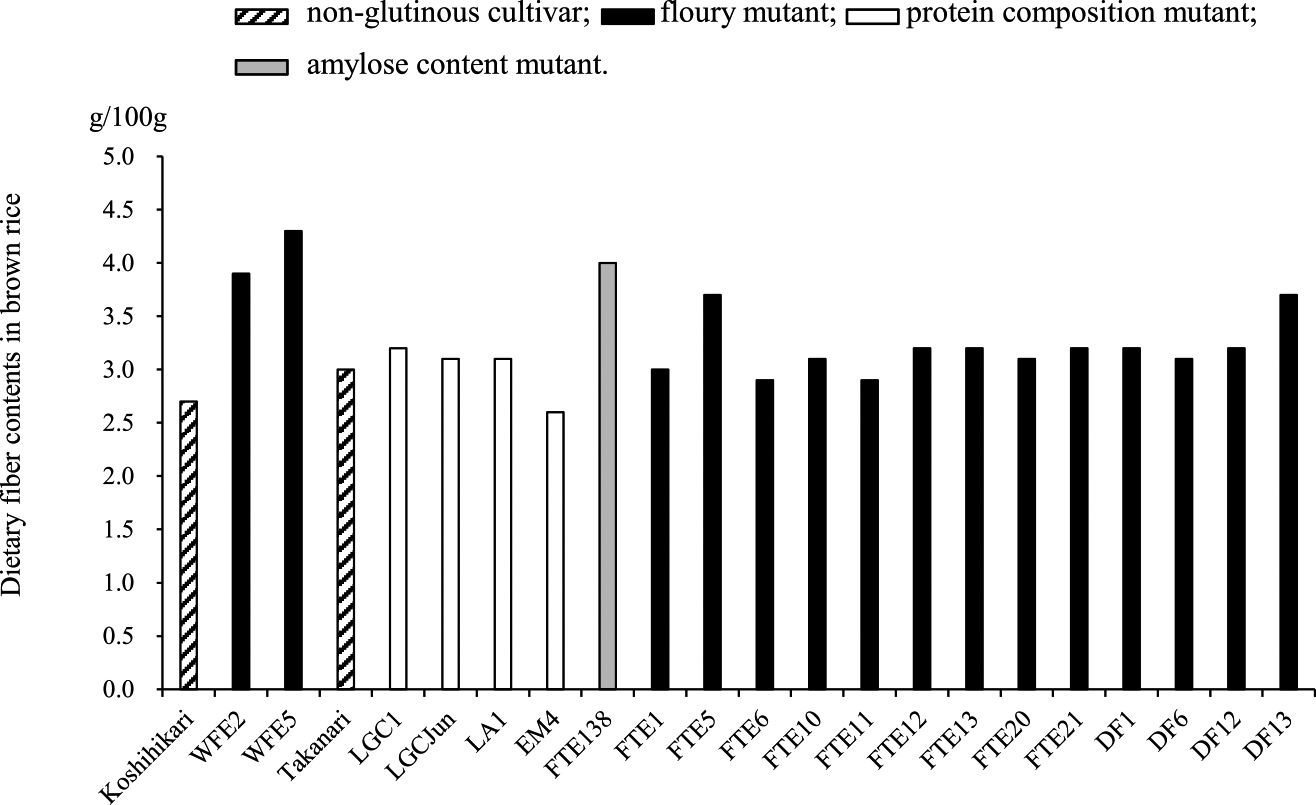
Screening for mutants with high dietary fiber content in brown rice.
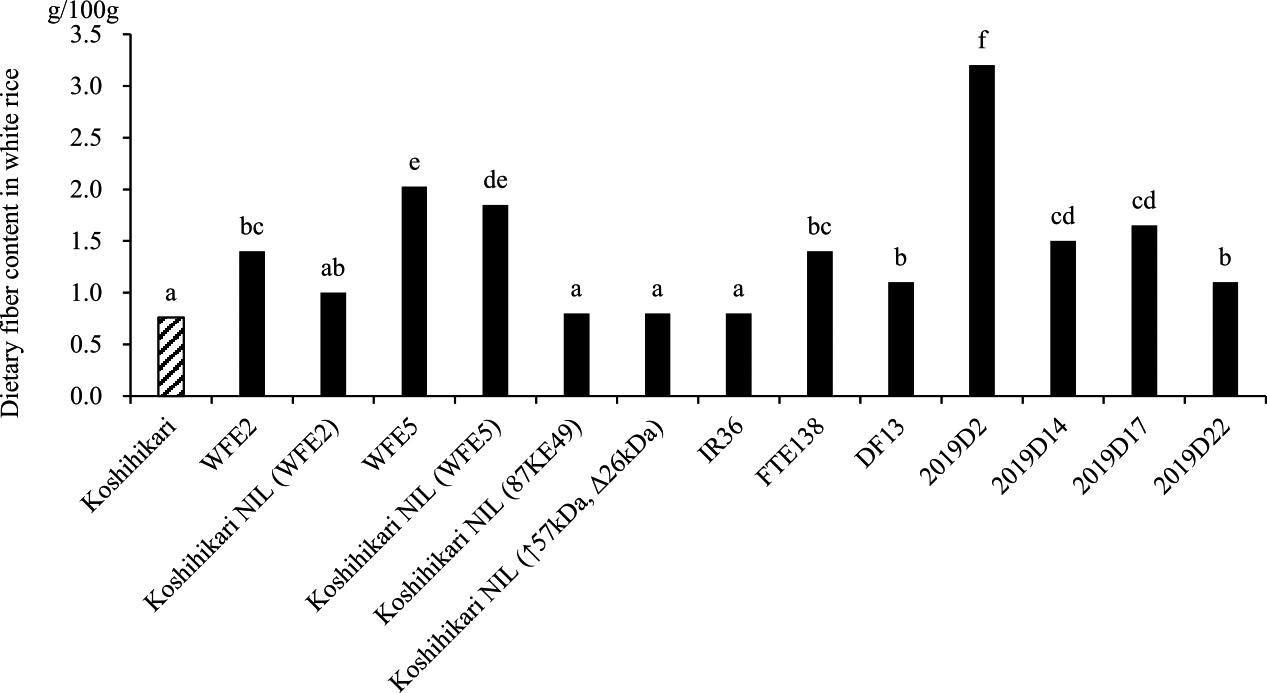
Dietary fiber content in white rice of mutants. Different letters indicate significant differences based on Fisher’s least significant difference test at α = 0.05.
WFE5 stood out in having a high hemicellulose content in brown rice (Fig. 3). ‘Beau-fiber’ barley, with high dietary fiber, is rich in (1-3,1-4)-β-D-glucan, a hemicellulose (Tono-oka et al. 2011). However, this glucan was not detected in WFE5 (data not shown).
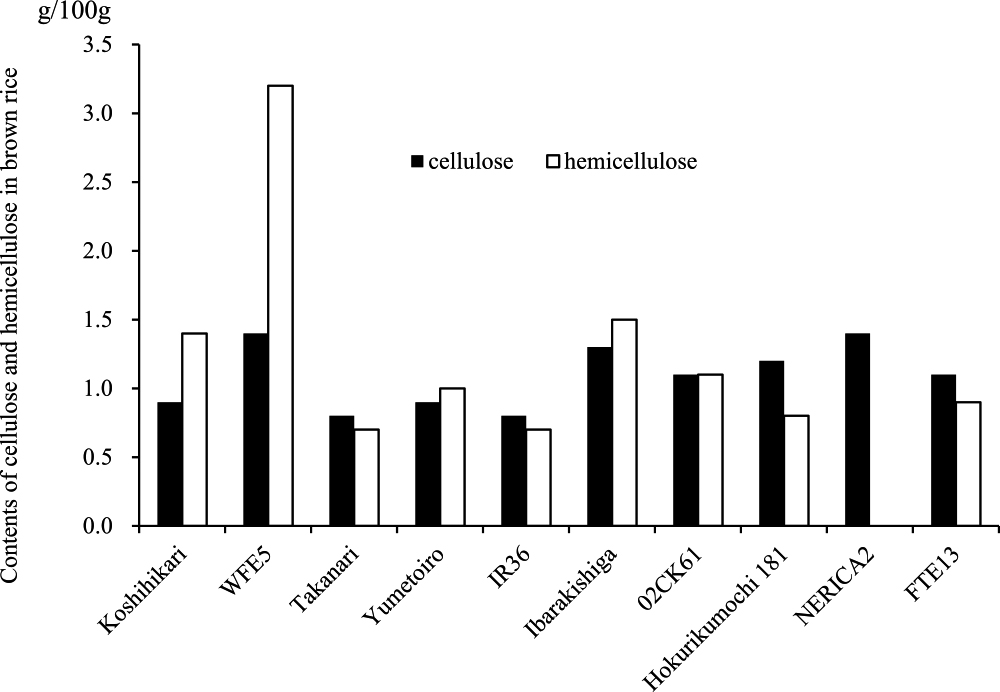
Varietal differences in content of cellulose and hemicellulose in brown rice. (Indica cultivars: Takanari, Yumetoiro, IR36, Hokurikumochi 181; Japanese upland cultivar: Ibarakishiga; NERICA cultivar: NERICA2; Koshihikari mutants: 02CK61, FTE13).
Both WFE2 and WFE5 have the floury trait, but to different degrees. According to pattern diagrams of cross-section type (Iida and Amano 1990), we determined them to be type A and type D, respectively (Table 2). Following two rounds of backcrossing to Koshihikari, we selected two NILs with the floury trait, NIL(WFE2) and NIL(WFE5). The floury traits of NIL(WFE5) fluctuated among types B to D, but the fiber content was near that of WFE5. The floury trait of NIL(WFE2) was type A, and the fiber content was similar to that of WFE2 (Table 2, Fig. 2).
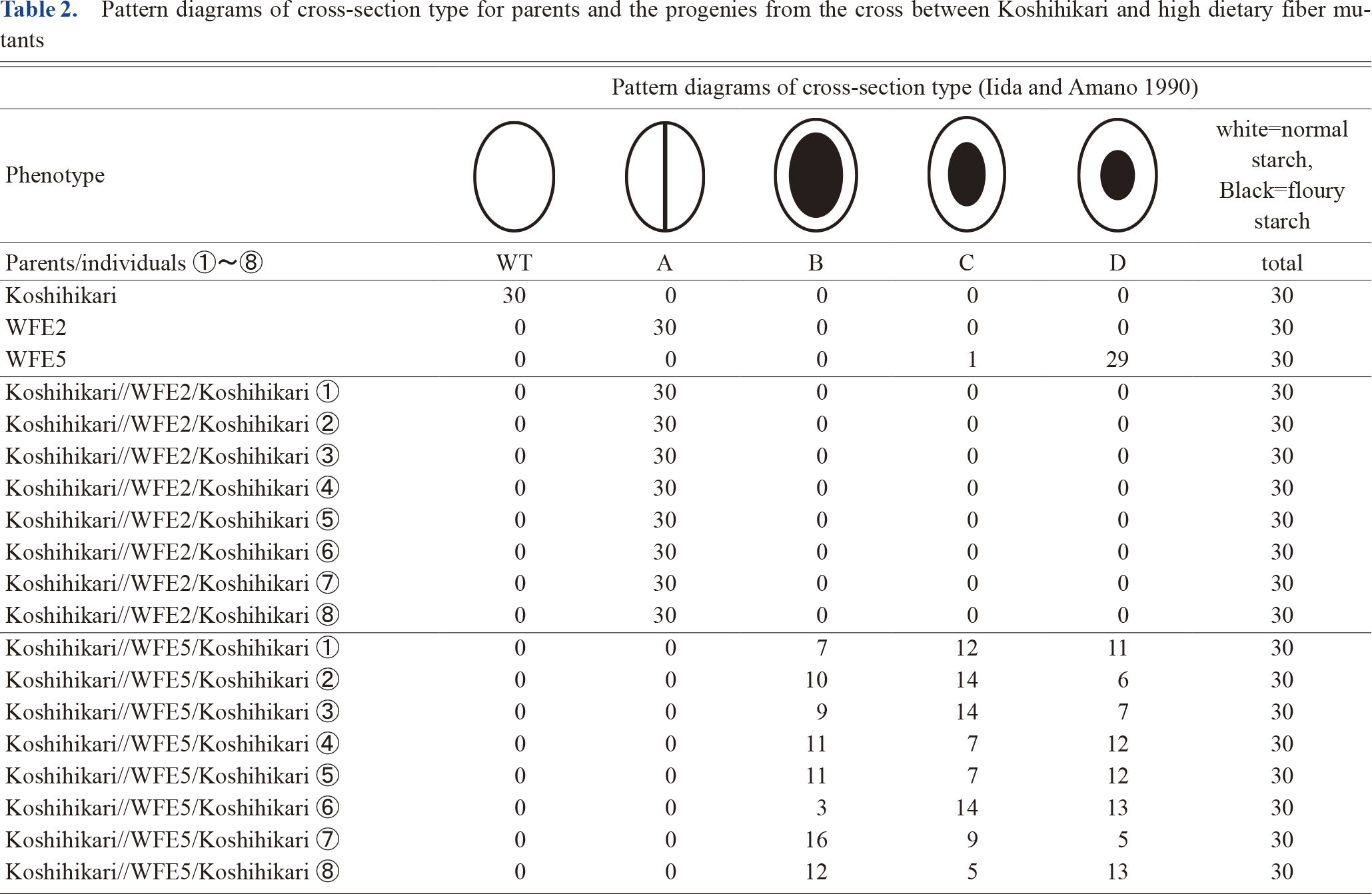
Pattern diagrams of cross-section type for parents and the progenies from the cross between Koshihikari and high dietary fiber mutants
The heading date, culm length, panicle length, panicle number, and lodging resistance of NIL(WFE5) were close to those of Koshihikari, but kernel weight and size were inferior. The low yield was due to the small grain size (Table 3).
| Crop year | Variety/Line | Heading date | Culm length (cm) | Panicle length (cm) | Panicle number (No./m2) | Lodging degreea | Yield (kg/a)b | Yield (kg/a)c | Rice screenings (kg/a) | 1000 kernel weightb (g) | Dietary fiber contents (g/100 g) | Amylose content in white rice (%) | Protein content in brown rice (%) | Short chain of amylopectin content in white rice (%) | |||
|---|---|---|---|---|---|---|---|---|---|---|---|---|---|---|---|---|---|
| Brown rice | White rice | ||||||||||||||||
| Total | Soluble | Insoluble | |||||||||||||||
| 2016 | Koshihikari NIL(WFE5) | 7.28 | 82 | 18.1 | 404 | 1.0 | 32.6 | 47.6 | 17.3 | 18.4 | 3.9 | ||||||
| Koshihikari | 7.27 | 84 | 19.1 | 375 | 2.0 | 60.3 | – | 6.4 | 21.8 | ||||||||
| 2017 | Koshihikari NIL(WFE5) | 7.21 | 91 | – | – | 1.5 | 48.6 | 53.6 | 5.7 | 20.8 | 5.4 | 2.4 | 0.1>> | 2.4 | 11.8 | 7.9 | 15.1 |
| Koshihikari | 7.21 | 92 | 19.4 | 441 | 1.8 | 63.0 | – | 1.7 | 24.0 | 1.8 | 0.8 | 0.2 | 0.6 | 15.2 | 6.9 | 14.3 | |
| WFE5 | 7.21 | 86 | – | – | 1.5 | 48.5 | – | 3.8 | 4.3 | 2.0 | 0.1 | 1.9 | |||||
| 2018 | Koshihikari NIL(WFE5) | 7.27 | 81 | 19.3 | 386 | 1.0 | 27.7 | 43.1 | 32.8 | 20.1 | 8.6 | 5.9 | 0.2 | 5.7 | 14.0 | 5.5 | 14.9 |
| Koshihikari | 7.27 | 82 | 20.1 | 372 | 2.0 | 52.1 | – | 4.9 | 23.4 | 4.1 | 1.5 | 0.2 | 1.3 | 15.1 | 5.2 | 14.2 | |
| 2019 | Koshihikari NIL(WFE5) | 7.28 | 88 | 19.4 | 474 | 0.8 | 33.8 | 41.1 | 8.4 | 17.2 | 4.9 | 2.8 | 0.2 | 2.6 | 8.1 | 7.5 | 14.8 |
| Koshihikari | 7.28 | 90 | 18.8 | 522 | 2.3 | 52.2 | – | 1.8 | 21.2 | 3.4 | 0.6 | 0.1>> | 0.6 | 13.0 | 6.5 | 13.5 | |
| Average | Koshihikari NIL(WFE5) | 7.26 | 86 | 18.9 | 421 | 1.1 | 35.7 | 46.4 | 16.1 | 19.1 | 6.3 | 3.7 | 0.2 | 3.6 | 11.3 | 7.0 | 14.8 |
| Koshihikari | 7.25 | 87 | 19.3 | 423 | 2.0 | 56.9 | – | 3.7 | 22.6 | 3.1 | 1.0 | 0.2 | 0.8 | 14.4 | 6.2 | 13.9 | |
a Lodging degree was 0 for erect plants and 5 for plants with lodging.
b Yield and 1000 kernel weight were measured using grains screened with 1.90 mm wire cloth test sieves.
c Yield measured using grains screened with 1.70 mm wire cloth test sieves.
Eating quality too was inferior to that of Koshihikari, as well as to that of ‘Nipponbare’ and ‘Akitakomachi’, which is rated lower than Koshihikari (Table 4). But although the eating quality of NIL(WFE5) is clearly inferior, its softness makes it superior to Nipponbare and to high-amylose ‘Koshinokaori’, which is used as a functional food (Table 4). Its softness is attributable to its lower amylose content and its higher short-chain amylopectin (degree of polymerization 6–10) content in white rice (Table 3).
| Crop year | Variety/Line | Stickiness | Softness | Overall | Standard variety |
|---|---|---|---|---|---|
| 2015 | Koshihikari NIL(WFE5)b,c | –0.33 | –0.44** | –1.28** | Koshihikari |
| Koshinokaori | –2.39** | 2.11** | –2.33** | ||
| Nipponbare | –0.33 | –0.28* | –0.33* | ||
| Koshihikari NIL(WFE5) | –1.44** | 0.83** | –1.61** | ||
| 2016 | Koshihikari NIL(WFE5) | –1.44** | 0.83** | –1.61** | Koshihikari |
| 2017 | Koshihikari NIL(WFE5) | –0.17 | –0.17 | –1.06** | Nipponbare |
| Nipponbare | –0.17 | 0.28 | –0.22 | ||
| 2018 | Koshihikari NIL(WFE5) | –1.06** | 0.56** | –1.22** | Akitakomachi |
*,**: Significant at the 5% and 1% levels, respectively.
a All values were rated at –3 to +3 by 18 assessors at Fukui Agriculture Experiment Station. For softness, a negative value indicates softer.
b NIL(WFE5) in 2015 consisted of 1/4 non-floury rice and 3/4 floury rice owing to the segregation of lines.
c Generally, NIL(WFE5) was evaluated as coarse, yellowish, and having poor stickiness and flavor.
Analysis of the dietary fiber content of NIL(WFE5) over 4 years showed that it was three times that of Koshihikari (Fig. 2) and was stable character over time or places (Table 3).
We showed the milling properties of Koshihikari and NIL(WFE5) in Table 5. The volume weight and the crushing rigidity of brown rice of NIL(WFE5) were smaller than those of Koshihikari. These results imply that NIL(WFE5) will be easily broken during milling. Although NIL(WFE5) is floury, less rice was broken during milling. The broken rice ratio after 90% milled by the grinding-type rice milling machine was almost the same as those of Koshihikari. The broken rice ratio milled by the friction-type rice milling machine was slightly more than those of Koshihikari, but the samples did not crack badly during the milling process.
| Year | Variety/Line | Volume weighta (g/l) | Crushing rigiditya (kg) | Friction-type milling machine | Grinding-type milling machine | |||
|---|---|---|---|---|---|---|---|---|
| Percentage of milled rice (%) | Broken rice ratio (%) | Percentage of milled rice (%) | Broken rice ratio (%) | |||||
| 2016 | Koshihikari NIL(WFE5) | 763 | 3.3 | – | – | – | – | |
| Koshihikari | 833 | 7.3 | – | – | – | – | ||
| 2019 | Koshihikari NIL(WFE5) | – | – | 89.7 | 4.0 | 90.0 | 2.0 | |
| Koshihikari | – | – | 90.2 | 2.6 | 90.5 | 2.5 | ||
| 2020 | Koshihikari NIL(WFE5) | – | – | 89.9 | 4.7 | 89.7 | 4.0 | |
| Koshihikari | – | – | 90.1 | 1.1 | 90.2 | 1.5 | ||
a Analyzed by SATAKE CORPORATION.
The concept that “a balanced diet supports a healthy body” has been emphasized throughout the ages, in the East and West. The importance of the daily diet is recognized in all societies. Bacterial gut symbionts play crucial roles in the functioning of the mammalian immune system (Sonnenburg and Sonnenburg 2018). Sonnenburg et al. (2005) showed that in the absence of polysaccharides in the diet, Bacteroides thetaiotaomicron can turn to host mucus glycans, creating intestinal disease. This example shows that we should feed an appropriate diet to our microbiota for the maintenance of our health. We need to develop effective ways to manipulate our microbial communities in order to promote health or treat disease.
NIL(WFE5) offers promise in improving dietary fiber intake in Japan, with triple the content in white rice, but its eating quality will need to be improved. Despite these aspects, NIL(WFE5) is superior to Nipponbare, or particularly Koshinokaori with a characteristic of high amylose content as a functional food in the item of softness (Table 4). A blend of equal parts Koshihikari and NIL(WFE5), with double the fiber content of Koshihikari alone, could improve the overall eating quality. Future studies of the eating quality of blends could identify the optimum proportions.
Although the broken rice ratio after 90% milled by the grinding-type rice milling machine was almost the same as Koshihikari, those by the friction-type rice milling machine was slightly more than Koshihikari. These results indicate that samples did not crack badly during the milling process. The reason for this is thought to be that not the entire part of NIL(WFE5) grain is floury, but the only central part of kernel is floury. In the result, there is a transparent layer of tightly packed starch around the floury core of brown rice, as shown in Table 2 and Fig. 4.
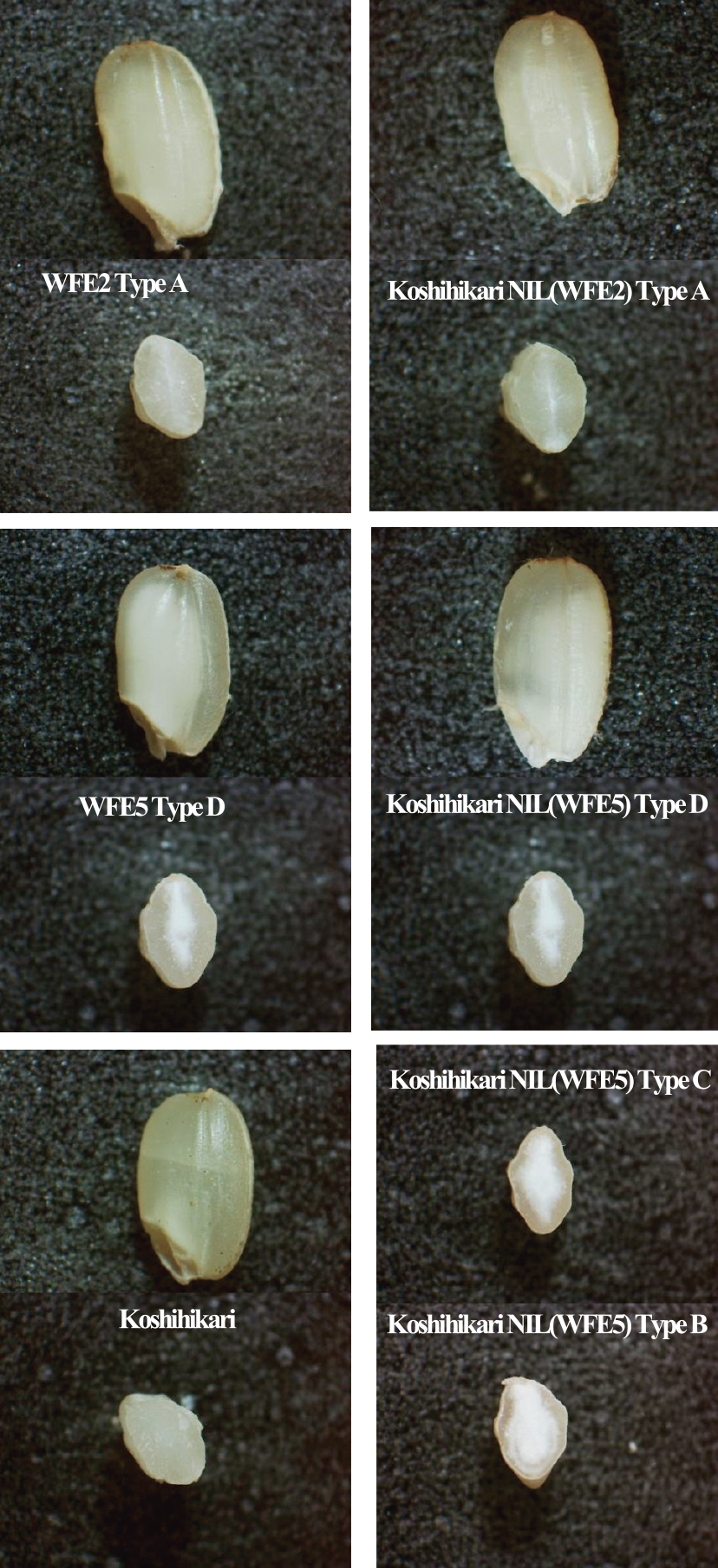
Photos of cross-section types in the parents and NILs from the cross between Koshihikari and mutants with high dietary fiber content (see Table 2). (Koshihikari, WFE2, WFE5, Koshihikari NIL(WFE2), Koshihikari NIL(WFE5)).
In addition to the poor eating quality, the small grain size could stand in the way of high yielding ability. Although we measured yield and 1000-kernel weight of grains screened through 1.90-mm mesh, this method is particularly for the popular rice brands such as Koshihikari or Akitakomachi, on the other hand in the case of rice for business purposes they are often measured after screening at 1.70 mm. On this basis, the yield of NIL(WFE5) is not necessarily inferior (Table 3). But despite its inferior traits, NIL(WFE5) has a valuable high dietary fiber content. Further work is required to breed high-fiber rice. We recently found a promising mutant with around quadruple the dietary fiber content in white rice (2019D2 in Fig. 2), and a mutant with both larger grains and higher dietary fiber content (unpublished data). Detailed analysis of these mutants is in progress.
The high fiber content of the traditional Japanese diet supports a healthy gut microbiota. Our goal is to restore the dietary fiber intake in Japan and thus the healthy gut flora.
Although the anticipated super-aging society will oblige us to think about the importance of maintaining health, good health takes work. We hope that high-fiber white rice, such as WFE5, can contribute to maintaining health in the super-aging society. Since the mode of inheritance of floury characters and high fiber content is relatively simple, we place our hopes on the breeding of new rice cultivars with higher dietary fiber content, higher yield, and good eating quality.
M.N. designed the study for screening the mutants and developed the plant materials. M.N., R.M., Y.I., Y.S. and I.O. investigated the traits of mutants and analyzed the data. A.K. and K.T. designed and performed the experiments to raise the lines. M.N. wrote the initial draft of the manuscript. A.K. and R.M. reviewed the manuscript.
This work was supported by a grant from the Ministry of Agriculture, Forestry and Fisheries of Japan (Genomics for Agricultural Innovation, grant No. AMR0003) and, in part, by the budget for Genomics-based Technology for Agricultural Improvement (grant No. IVG3001). The authors also thank SATAKE CORPORATION for volume weight and crushing rigidity measurement.